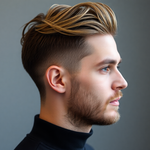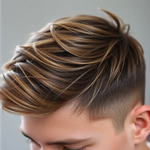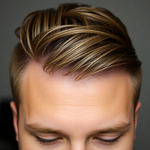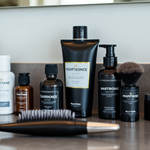
Closet-Audit Hack: Use Semi-Permanent Hair Color to Stop Overbuying and Perfect Your Men's Capsule Wardrobe
26 September 2025
Share
Hook: Stop impulse buys and build a capsule that actually works
Struggling to stop overbuying and create a wardrobe that feels intentional? The closet-audit hack: use semi-permanent hair color to stop overbuying and perfect your men's capsule wardrobe gives you a fast, low-risk way to test a seasonal color story on your most visible personal feature — your hair — before committing to new clothes. Try it and save money, time, and closet space.
Closet-Audit Hack: Use Semi-Permanent Hair Color to Stop Overbuying and Perfect Your Men's Capsule Wardrobe
This is the core technique: temporarily shift your hair tone to match a target palette for a week. Wearing the colors in practice reveals whether new purchases will actually harmonize with your look — or if they’ll end up in the donate pile. Semi-permanent dyes wash out in 4–8 shampoos, so the test is reversible and low-commitment.
Why this hack beats traditional closet audits
- Real-world testing: Photos and in-person wear give context that flat swatches or moodboards can’t.
- Reduces buyer's remorse: You only buy pieces that already work with your tested color story.
- Fast decisions: A 10–14 day experiment gives clear outcomes — keep, tailor, or pass.
- Sustainable: Fewer impulse buys = less waste. Quality over quantity.
How semi-permanent color interacts with a capsule wardrobe
Hair color affects perceived contrast, warmth, and how colors reflect on your face. A warmer hair tone can make earth tones and rusts pop; an ash/neutral tone can make navy and charcoal read cleaner. By shifting hair tone temporarily, you can answer whether a new color story elevates your overall aesthetic.
Before you start: quick safety and prep notes
- Always do a patch test at least 48 hours before full application to check for allergic reactions.
- If you have scalp issues or sensitive skin, consult a dermatologist. For safety guidance, see the American Academy of Dermatology: aad.org.
- Choose ammonia-free, low-damage semi-permanent formulas and follow package instructions carefully.
Step-by-step guide: Run the closet-audit (10–14 day plan)
-
Pick a target palette (1 day)
- Decide on 2–3 base neutrals (e.g., navy, charcoal, olive) and 1 accent (e.g., rust or burgundy).
- Consider season and events — 2025’s trend leaning toward earthy tones and versatile technical fabrics.
-
Choose the right semi-permanent shade (1 day)
- For warmer palettes, pick a shade with warm undertones (golden brown, chestnut). For cooler palettes, try ash or neutral tones.
- If unsure, consult a stylist for a 10-minute color consult or choose a mild tone-on-tone product.
-
Apply and start the test (day 2)
- Do the full application at home or with a stylist. Protect collars and towels; semi-permanent dyes can stain fabric.
- Document the starting look with photos in natural and indoor lighting.
-
Wear curated outfits (days 3–9)
- Plan 7 outfits covering work, casual, and one dressier look. Take photos and note confidence, compliments, and how colors read on camera.
- Switch footwear and accessories to evaluate the full effect (belt, shoes, watch strap).
-
Analyze and act (days 10–14)
- Keep items that harmonize with the tested hair tone. Alter or donate items that clash.
- Create a short shopping list for gaps — 3 to 5 intentional buys to complete the capsule.
Color theory basics for men: what to test and why
- Contrast level: Higher contrast (dark hair, light skin) pairs well with sharper neutrals like black and white. Lower contrast favors tonal outfits in navy, olive, and tan.
- Undertone harmony: Warm hair + warm clothing tones (rust, camel) = cohesive vibe. Cool hair + cool tones (charcoal, slate) = crisp look.
- Accent colors: Try one accent color to avoid a fragmented wardrobe. Accent should harmonize with your hair test.
Practical wardrobe edit after the audit
Sort your closet into four piles: keep, tailor, sell/donate, uncertain. Use the test photos as the tie-breaker for uncertain items. If an item gets zero use during the test week, it’s a candidate to move on.
Example capsule templates based on test results
Below are starting templates tailored to common outcomes of the hair color test.
-
Warm-tone test (best with rust/olive palette)
- 1 tan wool coat, 1 olive chore jacket, 2 rust/teracotta knits, dark denim, olive chinos, brown derby shoes, EcoSneak for weekends.
-
Cool-tone test (navy/charcoal focused)
- 1 navy blazer, charcoal trousers, navy knit, white tee, dark denim, charcoal overcoat, sleek leather sneakers.
-
Neutral-tone test (versatile minimalist)
- Charcoal blazer, stone knit, navy jeans, olive chino, black boots, minimalist leather belt.
Tailoring the approach to different men (18–45)
- Young professionals (20s–30s) — Focus on versatile blazers, smart-casual shoes, and polished outerwear you can wear to interviews and nights out. The hair test helps you pick blazer and shirt tones that read confident on video calls.
- Students and creatives — Emphasize mix-and-match layers, denim, and statement knitwear. Use bolder accent colors during the test to see what complements your vibe.
- Budget-conscious shoppers — Prioritize 3–4 core pieces revealed by the audit. Resist quantity; buy one high-quality item rather than three cheap ones.
- Fitness-minded men — Consider how color choices highlight body shape. Darker, tonal outfits often look slimming and more refined.
Grooming & maintenance: making the temporary color look high-end
- Use sulfate-free shampoos to extend color life and keep hair glossy.
- Invest in a small styling routine: a lightweight pomade or cream can refine the look and pull outfits together.
- Document how different grooming choices interact with the tested color; small tweaks can change a whole outfit’s vibe.
Visual assets: how to document the test for repeatable results
- Create a simple photo log: morning natural light, office/indoor light, and evening outdoor light.
- Use Jolt’s image generator to create mood images for your target palette if you need visuals for reference.
- Write short captions and include alt text for each photo when you save them (example alt text: 'Man wearing navy blazer and charcoal trousers, warm chestnut hair tone').
Common mistakes and how to avoid them
- Changing hair and buying new clothes at the same time — test first, buy second.
- Trusting store lighting — always check outfits outdoors and in multiple indoor light types.
- Overcomplicating the palette — keep it to 3 neutrals + 1 accent during the test.
Menll.com picks to complete your capsule
Keep purchases intentional. Menll.com offers durable, eco-conscious essentials that fit capsule logic. For example, Menll.com's EcoSneak is a great weekend shoe for tested neutral palettes, and their outerwear collection provides season-proof jackets that pair with warm or cool hair tests. Check Menll.com's outerwear to find staple layers: Menll.com outerwear.
Case study: Alex's two-week experiment
Alex, 31, marketing manager, had a closet dominated by mismatched imports — too many colors, nothing cohesive. He tested a warm chestnut tone to harmonize with olive chinos and rust knits he already owned. Outcome: his rust pieces suddenly read intentional, three shirts got more wear, and he sold five items. His audit revealed only two purchases were needed: a navy over-shirt and a pair of brown derbies. He saved money and gained daily outfit confidence.
Beyond color: using the audit to refine fit and silhouette
Use the same test photos to evaluate fit. Ask: does the blazer sleeve length feel right? Do trousers sit flattering at the waist? If something fits poorly but matches the palette, prioritize tailoring over replacement — often cheaper and more sustainable.
Meta guidance for publishing
Meta title: Closet-Audit Hack — Semi-Permanent Color & Capsule Wardrobe (50–60 chars)
Meta description: Try this closet-audit hack using semi-permanent hair color to stop overbuying and build a cohesive men's capsule wardrobe. Practical steps, safety tips, and templates. (150–160 chars)
Final checklist: launch your own closet-audit (copyable)
- Pick your palette (2–3 neutrals + 1 accent).
- Choose a semi-permanent shade and patch-test.
- Document baseline photos.
- Wear planned outfits for 7 days; take photos in varied light.
- Sort closet: keep, tailor, sell/donate, uncertain.
- Buy intentionally: 1–5 gap pieces only.
- Tailor high-value items rather than replacing.
Closing & one soft call-to-action
Ready to stop overbuying and build a capsule that actually works? Try this closet-audit hack and use the test findings to shop smarter. Share your experiment results in the comments — and if you need season-proof essentials, browse Menll.com for durable, sustainable pieces like the EcoSneak and reliable outerwear.
Prev post
Next post

Semi-Permanent Hair Color: Build an Outfit Matrix to Buy Less and Maximize Your Sustainable Men's Capsule Wardrobe
Updated on 25 September 2025






